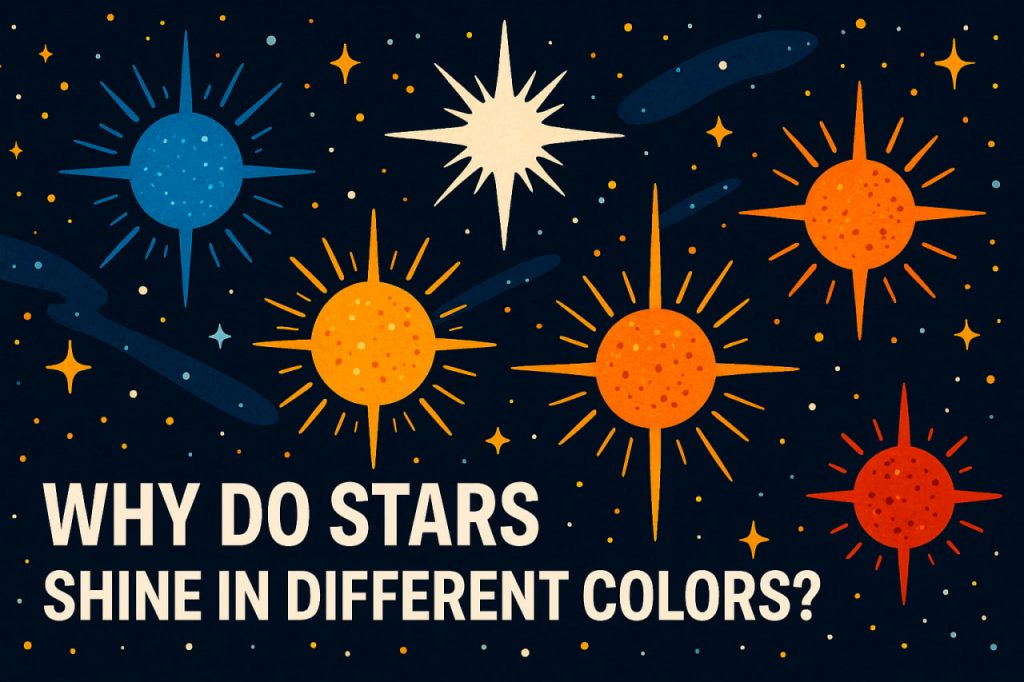When you look at the night sky, you may notice that not all stars appear white. Some shine with a bluish tint, others with a reddish or yellow glow. These colors are not illusions—they reveal important information about a star’s temperature, composition, and life stage. The color of a star is determined primarily by the physics of blackbody radiation, where hotter objects emit shorter wavelengths of light and cooler ones emit longer wavelengths.
Understanding why stars shine in different colors gives astronomers valuable clues about their nature, helping us classify them and trace the history of the universe.
Temperature Determines Color
The primary factor affecting a star’s color is its surface temperature. Stars act as nearly perfect blackbodies, emitting a continuous spectrum of light. The Wien’s Law tells us that the wavelength of peak emission shifts with temperature:
- Hotter stars (above 10,000 K) emit more light in the blue or white part of the spectrum.
- Cooler stars (below 4,000 K) emit more in the red or orange wavelengths.
- Intermediate stars, like the Sun (~5,800 K), appear yellowish-white.
This relationship explains why stars like Sirius shine blue-white, while Betelgeuse glows red.
Stellar Spectral Classification
Astronomers classify stars into spectral types based on temperature and color:
O, B, A, F, G, K, M, with O-type stars being the hottest and M-type the coolest. Each class has a distinct color:
- O and B: blue or blue-white
- A and F: white
- G (e.g., the Sun): yellow
- K: orange
- M: red
This classification also reflects differences in mass, size, and lifespan. Massive blue stars burn fast and live briefly, while red dwarfs burn slowly and last billions of years.
The Role of Elements and Atmosphere
While temperature is the main factor, a star’s chemical composition and atmosphere also affect its light. Certain elements absorb specific wavelengths, creating absorption lines in the star’s spectrum. These don’t change the basic color but add unique “fingerprints” that allow astronomers to analyze what elements are present.
Additionally, stellar metallicity—the proportion of elements heavier than hydrogen and helium—can subtly influence the color, especially in older stars.
Motion and Color: The Doppler Effect
Sometimes, a star’s motion relative to Earth can cause its light to shift in color. This is called the Doppler effect:
- Stars moving toward us are blueshifted (light becomes shorter in wavelength).
- Stars moving away are redshifted (light becomes longer in wavelength).
While these shifts are usually too small to notice with the naked eye, they are vital for measuring the expansion of the universe and detecting exoplanets.
What We Learn From Star Colors
Star color is more than just visual—it’s a gateway to understanding stellar evolution. Color tells us about:
- A star’s temperature and energy output
- Its size and mass
- Its age and life expectancy
- Its distance (when combined with brightness)
By analyzing star colors in distant galaxies, astronomers can study cosmic history and determine how galaxies evolve over time.
Glossary
- Blackbody radiation – emission of light by an object based on its temperature
- Wien’s Law – a physical law that links temperature with peak light wavelength
- Spectral type – a classification system for stars based on their color and temperature
- Absorption lines – dark lines in a spectrum caused by elements absorbing light
- Doppler effect – change in wavelength due to relative motion between source and observer
- Redshift – lengthening of light wavelength, indicating a star is moving away
- Blueshift – shortening of light wavelength, indicating a star is approaching


